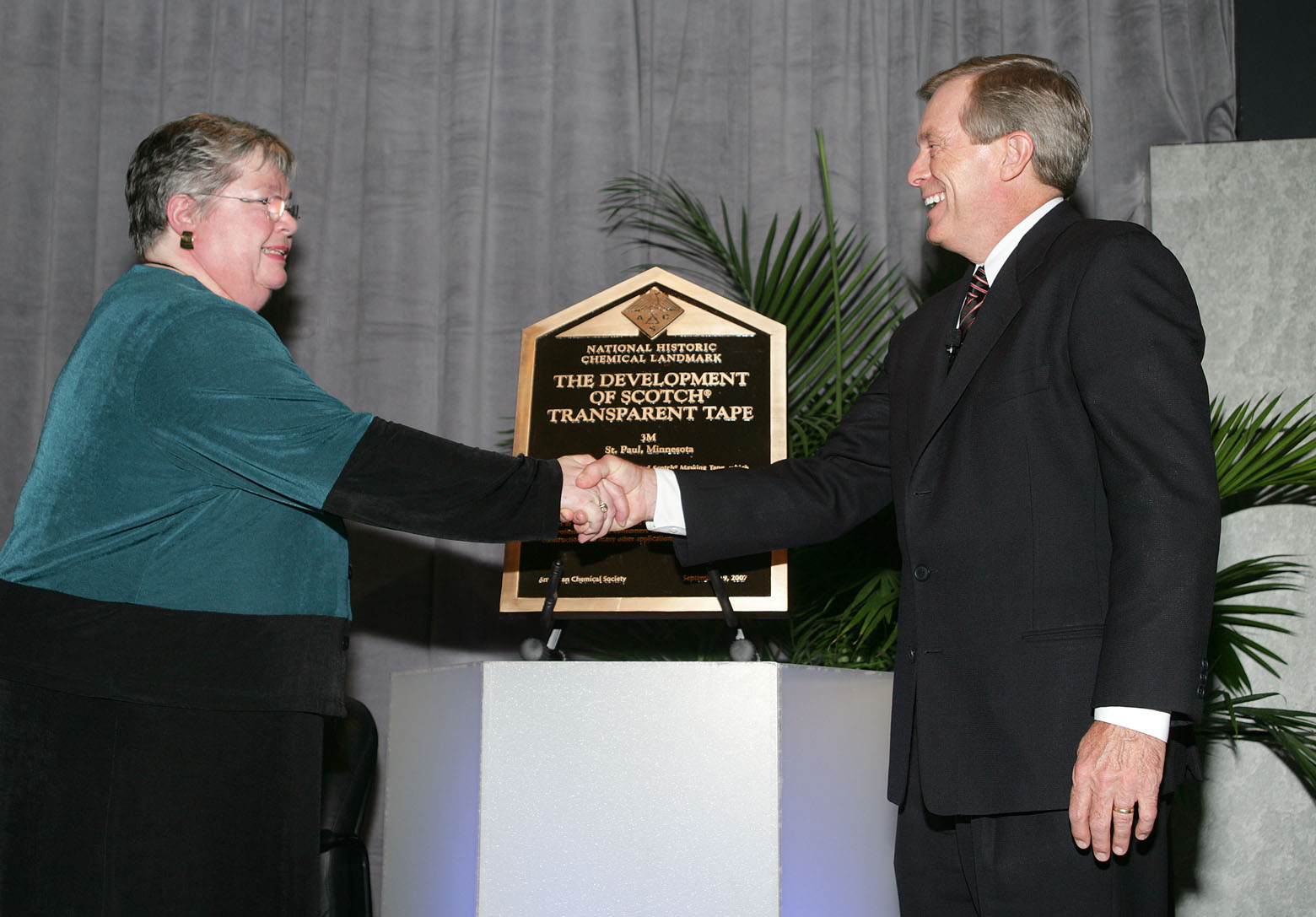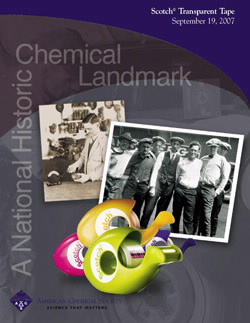Scotch Transparent Tape
Dedicated September 19, 2007, at 3M Company in St. Paul, Minnesota.
It's been used for everything from wrapping gifts to protecting blimps. It is so commonplace that it is easy to take for granted. Yet Scotch® Transparent Tape has an extraordinary history marked with audacity, serendipity, and "stick-to-itiveness." For a time in its early development, the very idea of transparent tape seemed ludicrous as each day stacks of spoiled cellophane piled up several feet high on a laboratory floor. Yet driven by what was to become a corporate credo—"Thou shalt not kill a new product idea"—Minnesota Mining and Manufacturing (3M) engineers persisted and ultimately triumphed, creating what was to become one of the most ubiquitous and successful products ever developed.
Contents
- Richard Drew Solves the Painter’s Problem with the Invention of Masking Tape
- Development of Scotch® Transparent Tape
- Legacy of Scotch® Tape: Depression-era Fix-all, and Later Scotch® Products
- How Adhesive Tape Is Made
- Invention of the Tape Dispenser
- Scotch® Tape Timeline
- Further Reading
- Landmark Designation and Acknowledgments
- Cite this Page
Richard Drew Solves the Painter’s Problem
with the Invention of Masking Tape
Producing the first roll of Scotch® Tape wasn't just a challenge, it was something of a marvel considering that it was the brainchild of a banjo-playing, engineering school dropout who had a limited background in chemistry and who had no idea what he was getting into when he told a client he could solve his problem.
The problem facing Richard (Dick) G. Drew, a 23-year-old 3M research assistant, was a big one. And his ingenious solution—masking tape—would revolutionize 3M and set the stage for eventual development of Scotch® Transparent Tape.
By the early 1920s, two-toned cars were the rage, and that created a major headache for the automotive industry. To craft this duo-tone look, one portion of the car had to be masked off while the other was painted. The problem was nobody knew how to do this well. So automakers and auto body shops improvised. They glued old newspapers to the body and windows with library pastes, homemade glues or surgical adhesive tape. This helped create a sharp demarcation between the two colors, but the adhesives stuck so firmly that trying to remove them often ruined the paint job.
At the time, 3M primarily manufactured sandpaper and other abrasives. One of Dick Drew's jobs was taking samples of waterproof sandpaper (another 3M invention) to nearby auto body shops for testing. One morning in 1923 he walked into one of these shops and overheard "choicest profanity I'd ever known." Yet another paint job was botched and the worker who'd done it was furious. Drew had seen this occur on many other visits, but this time he spoke up. He could, he said, produce a tape that would end the painter's torment.
It was a brash pledge since, as one historian noted, "(Drew) could back this promise with neither experience nor know-how. He didn't even know exactly what was needed, but he had the optimism of youth." It also helped that he received the backing of his superiors at 3M, who were looking for ways to diversify the company. Still, Drew hardly seemed like an innovator.
Growing up in St. Paul, Minn., Drew spent much of his time playing banjo in local dance bands. Using this talent, he earned enough to pay for engineering classes at the University of Minnesota. But the demands of playing in bands at night and taking classes during the day proved too much. He dropped out of school after eighteen months and took a correspondence course in machine design. In 1921, he was hired by 3M and all too soon he was trying to figure out how to deliver on his impulsive promise to that auto painter.
Using the adhesive used in 3M's waterproof sandpaper as a starting point, Drew spent two years experimenting with vegetable oils, various resins, chicle, linseed, and glue glycerin. Eventually he developed a formula containing a good grade of cabinetmaker's glue, which was kept sticky with the addition of glycerin. For a backing, he settled on treated crepe paper. The product he created; Scotch® Brand Masking Tape adhered strongly yet stripped off easily without mucking up paint. It was the first of what was to become a sprawling family of Scotch® Brand tapes. But it was Drew's second Scotch® Brand innovation still known as "the famous one" that would really set the world abuzz.
Development of Scotch® Transparent Tape
Serendipity fascinated Dick Drew. It is, he said, "the gift of finding something valuable in something not even sought out." And that was never truer than for transparent cellophane tape, a product Drew designed for one purpose but ended up being used in ways that no one at 3M could have imagined.
Drew's serendipitous quest began in 1929, four years after the introduction of Scotch® Brand Masking Tape. Flaxlinum Company, a St. Paul insulation firm, contracted to insulate several hundred railroad refrigerator cars, but there was a complication. The insulated bats needed to be wrapped and sealed with something moisture-proof so they could be used in the refrigerated cars. The company thought Scotch Brand Masking Tape would work. It didn't. Drew, now technical director of 3M's Product Fabrication Laboratory, plunged in. He and his team worked diligently, but after numerous attempts came up empty handed. Nothing, it seemed, was sufficiently watertight.
In the meantime, DuPont had developed cellophane, a moisture-proof packaging material. Another 3M employee, who was considering ways to package Scotch® Masking Tape in this new material, showed a sample to Drew, who immediately saw its potential to solve his latest challenge.
Tests showed cellophane would work as a backing for pressure-sensitive tape. Elated, Drew conducted more experiments, convinced he had found the solution to Flaxlinum's dilemma. By then, however, Flaxlinum was no longer interested. But many other industries were. In particular, bakers, meat packers, grocers, and confectioners who had adopted cellophane food wrap were clamoring for a moisture-proof and attractive way to seal their new packaging.
So Drew and his assistants pressed on. It took them almost a year to produce a marketable product, including what some would recall as "the longest and most discouraging months in 3M's history." The cellophane curled near heat and split as it was being coated by machine. It often broke or tore before a full roll was coated. The adhesive wouldn't adhere evenly. The dark amber adhesive spoiled the look of the colorless, transparent cellophane.
Gradually, Drew's team overcame these difficulties. They designed machinery that prevented splits and breaks. Instead of standard masking tape adhesive, they developed a new, nearly colorless one made from oils, resins, and rubber which helped keep the cellophane transparent. They found that using a primer helped the adhesive hold evenly along the backing.
On September 8, 1930, 3M sent its first roll of cellophane tape to a prospective client, who enthusiastically endorsed it. Still, the product, originally called Scotch® Brand Cellulose Tape and later renamed Scotch® Transparent Tape, appeared to face an uncertain future. DuPont had developed a heat-sealing process for cellophane, greatly reducing the demand for tape as a commercial package sealer. It was also the first full year of the Depression, a seemingly bad time to introduce a new product. But Scotch® Brand Cellulose Tape would soon prove that even in the worst of times opportunities for success abound.
Scotch® Tape: Great Depression-era Fix-all and Scotch® Legacy
In an era when thrift wasn't just a virtue, but a necessity, Scotch® Brand Cellulose Tape virtually sold itself. Almost daily, new ideas sprang up for using the tape to make old things do. It was used to mend book pages, sheet music, window curtains, and even small rips in clothing. Bankers used it to repair paper currency. Secretaries found it perfect for patching broken fingernails. Farmers discovered they could use it to seal cracked eggs. Housewives used it to cap canned milk, remove lint from clothing, secure bait on mousetraps, and repair cracked ceiling plaster. Goodyear used the tape to cover the inner ribs and beams of its dirigibles, creating an anti-corrosive shield.
As a result, 3M prospered and was one of the few companies in the world that didn't lay off employees during the Depression. In the years ahead, 3M would continue responding to consumer demand, developing numerous specialized tapes for household and industrial use. During World War II, almost all of 3M's tape production was diverted to the war effort. The company developed more than 100 types of tape to solve war production problems, such as sealing and labeling parts.
Rubber shortages during the war prompted 3M to switch to synthetic acrylate adhesives. Although not as strong, acrylate adhesives retained their clarity and actually aged better than rubber-based adhesives, which turned yellow and brittle over time. Later, acrylate adhesives would be mated with an acetate backing to create "invisible" Scotch® Magic™ Tape, the first tape that could be written on with pencil, pen, or marker.
Today, Scotch® Transparent Tape remains a mainstay of 3M's highly diversified, multibillion dollar global enterprise. It's estimated that transparent tapes are used in more than 90 percent of American homes.
The tape that Dick Drew conceived so many years ago has been to the moon (as insulation on a lunar lander), featured on Saturday Night Live, and immortalized in fine art. But Drew, who died in 1980 at age 81, never gave up trying to find something better. As a result of his tinkering, which was continued by those who followed in his footsteps, 3M developed a number of breakthrough adhesive products including 3M Micropore™ Surgical Tape®, Scotch® Pop-Up Tape Strips, and Post-it® Notes. Yet despite his many successes, which led to his 2007 induction into the National Inventors Hall of Fame, Drew never forgot how a bit of sandpaper changed his life.
"Would there have been any masking or cellophane tape if it hadn't been for earlier 3M research on adhesive binders for (waterproof) abrasive paper?" He once asked rhetorically. "Probably not."
How Adhesive Tape Is Made
All pressure-sensitive tapes share two common, but deceptively simple, traits: They all have some sort of adhesive attached to a backing. Yet to make this dynamic duo work requires as many as 30 raw materials and a bit of complex chemistry.
Using Scotch® Magic™ Tape, a later version of the product, as an example, producing the adhesive polymer starts with a mixture of alcohols and acids. Certain portions of distillate from crude oil are chemically reacted to form the desired raw materials. These materials are combined in water or a hydrocarbon solvent in carefully controlled proportions and are polymerized to form the final adhesive product.
As for the cellulose acetate backing, its manufacture begins with wood pulp or cotton linters. These cellulose fibers are broken down by chemical and physical means to their basic fiber structure. A plasticizer is added to the cellulose acetate, which is then formed into sheets of film. Finally, the surface of the film is treated to give it a matte finish. The finished film is wound up in large rolls, ready to be coated with adhesive.
Once the adhesive and backing are ready, several steps are required to produce a roll of tape. First, the cellulose acetate film is surface treated. One side of the film is treated with a release coating, which makes the tape easy to unwind. The other side is treated with a primer that ensures good anchorage of the adhesive film. A thin coating of pressure-sensitive adhesive is metered onto the film and dried.
The adhesive-coated tape is wound up to form a large jumbo roll. The jumbo roll is then split into narrow bands, which are wound on individual cores to produce the retail or commercial size rolls of tape.
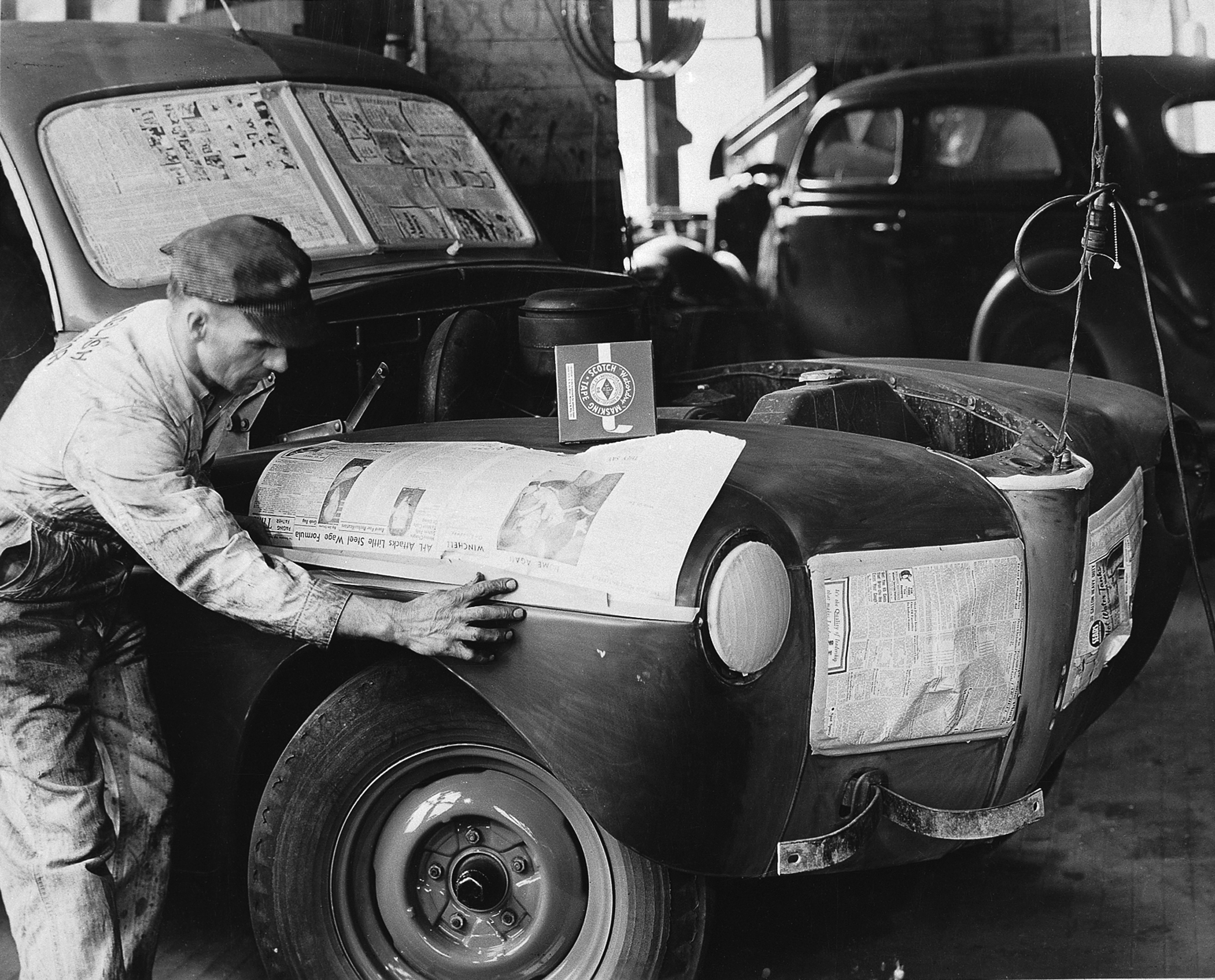
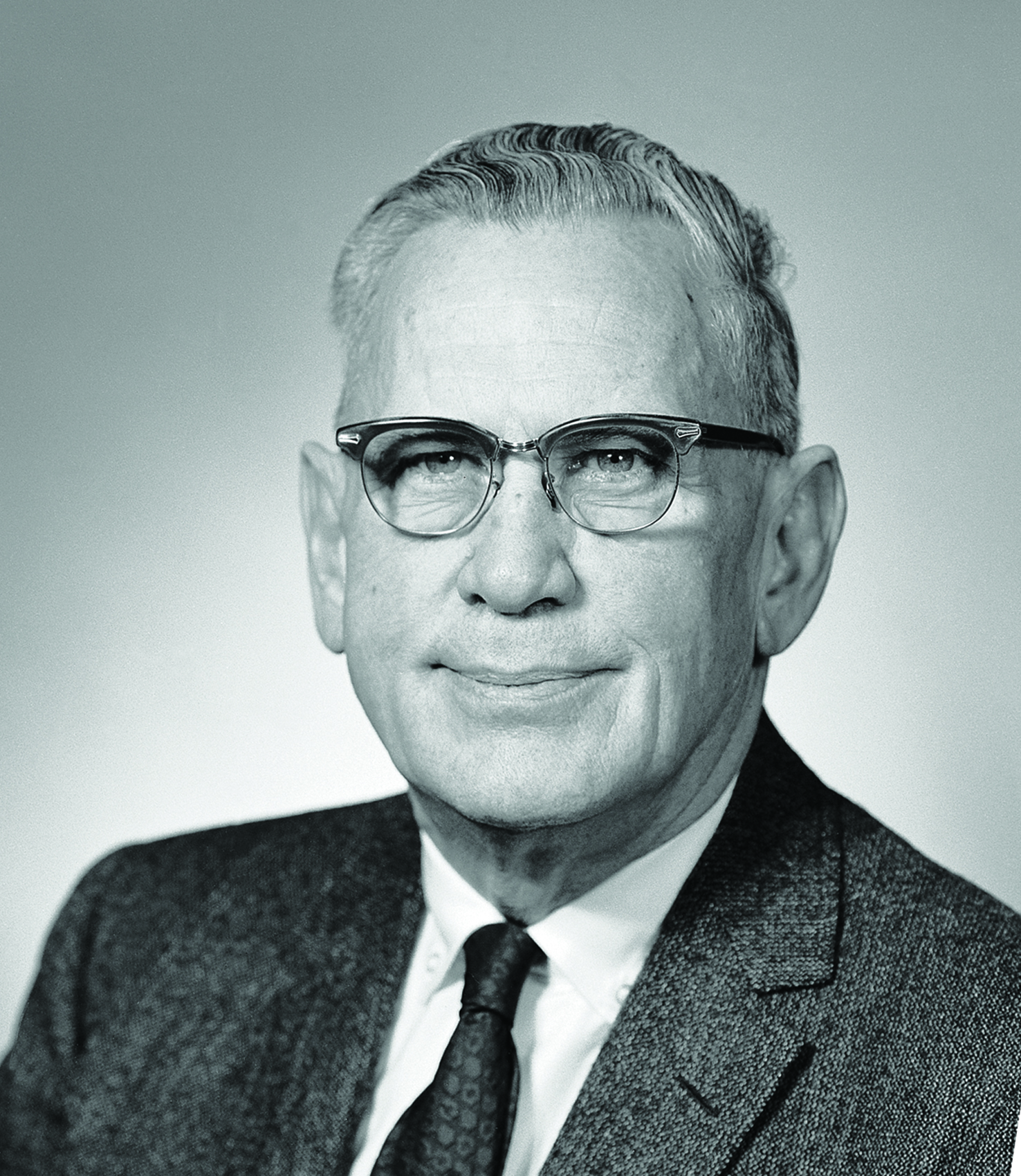
Invention of the Tape Dispenser
Soon after it was introduced in 1930, consumers discovered that Scotch® Cellulose Tape was—literally—almost indispensable.
While the tape itself worked great once it was applied, getting it off the roll wasn't easy. The end had to be picked loose with a fingernail or other sharp instrument. Once free, the tape didn't stay that way for long. Invariably, the loose end would curl back into place on the roll, become virtually invisible, and hard to locate. Frequently, the tape tore before the desired length was cut. Even if users succeeded in getting the right amount of tape, it had to be cut off with scissors or torn haphazardly, a time-consuming and awkward task. As a result, tempers flared and complaints rolled in.
Clearly the long-term success of this new product hinged on finding a better way to mete it out. But what? John Borden, a 3M sales manager, took on the task. In 1932, after eighteen months of experimenting, Borden developed an efficient dispenser with a built-in cutter blade. The dispenser allowed the tape to be unwound, cut, and applied in seconds. It even kept the end of the tape free for the next application. Although there would be changes over the years—including the introduction of the iconic snail-shaped tape dispenser in 1939—Borden's basic design has remained a standard
Borden's dispenser became a key element in the growing market for cellophane tape. Without it, it's unlikely that Scotch® tape would have become truly indispensable in factories, homes, and offices around the world.
Scotch® Tape Timeline
1921: Sandpaper manufacturer 3M hires Richard Drew as lab assistant.
1925: Drew invents Scotch® Masking Tape, the predecessor to transparent tape. This marks 3M's entry into the tape business. The first tape was a two-inch-wide tan paper strip backed with a light, pressure-sensitive adhesive.
1930: Drew develops the first waterproof, clear adhesive tape: Scotch® Cellulose Tape, later renamed Scotch® Transparent Tape.
1932: 3M's John Borden designs the first heavy-duty tape dispenser with a built-in cutter blade.
1945: After World War II, 3M resumes shipments of tapes for civilian use. More than 100 different types of Scotch tapes had been developed to meet wartime requirements. The famous plaid design is introduced to Scotch tape packages.
1961: Scotch® Magic™ Tape is launched. More than just transparent, the matte finish tape is virtually invisible on light-colored paper and can be written on with pen, pencil, or marker.
1978: Emerging comedy TV show, Saturday Night Live, pokes fun at the popularity of Scotch® tape. In a skit called "Scotch Boutique," the owners of a new store sell nothing but Scotch® tape, demonstrating the countless and endlessly quirky uses of this iconic product.
1985-86: In a national Roper opinion poll, Scotch® tape is voted the most indispensable product in the home. Scotch® tape is also honored by a leading consumer magazine as one of the "50 small wonders and big deals that revolutionized the lives of consumers."
1997: 3M introduces Scotch® Pop-Up Tape Strips—precut, 2-inch tape pieces and a one-hand, pop-up dispensing.
2004: Scotch® tape is named a "Humble Masterpiece" by the Museum of Modern Art in New York. The exhibit features more than 100 simple items, including Scotch tape, that are described as "masterpieces of design deserving our admiration."
2007: Richard Drew inducted into the National Inventors Hall of Fame. Scotch® Transparent Tape recognized as a National Historic Chemical Landmark.
Further Reading
- 3M Awards (2007 Recognition) (3M Company)
- Richard G. (Gurley) Drew biography (Minnesota Science & Technology Hall of Fame)
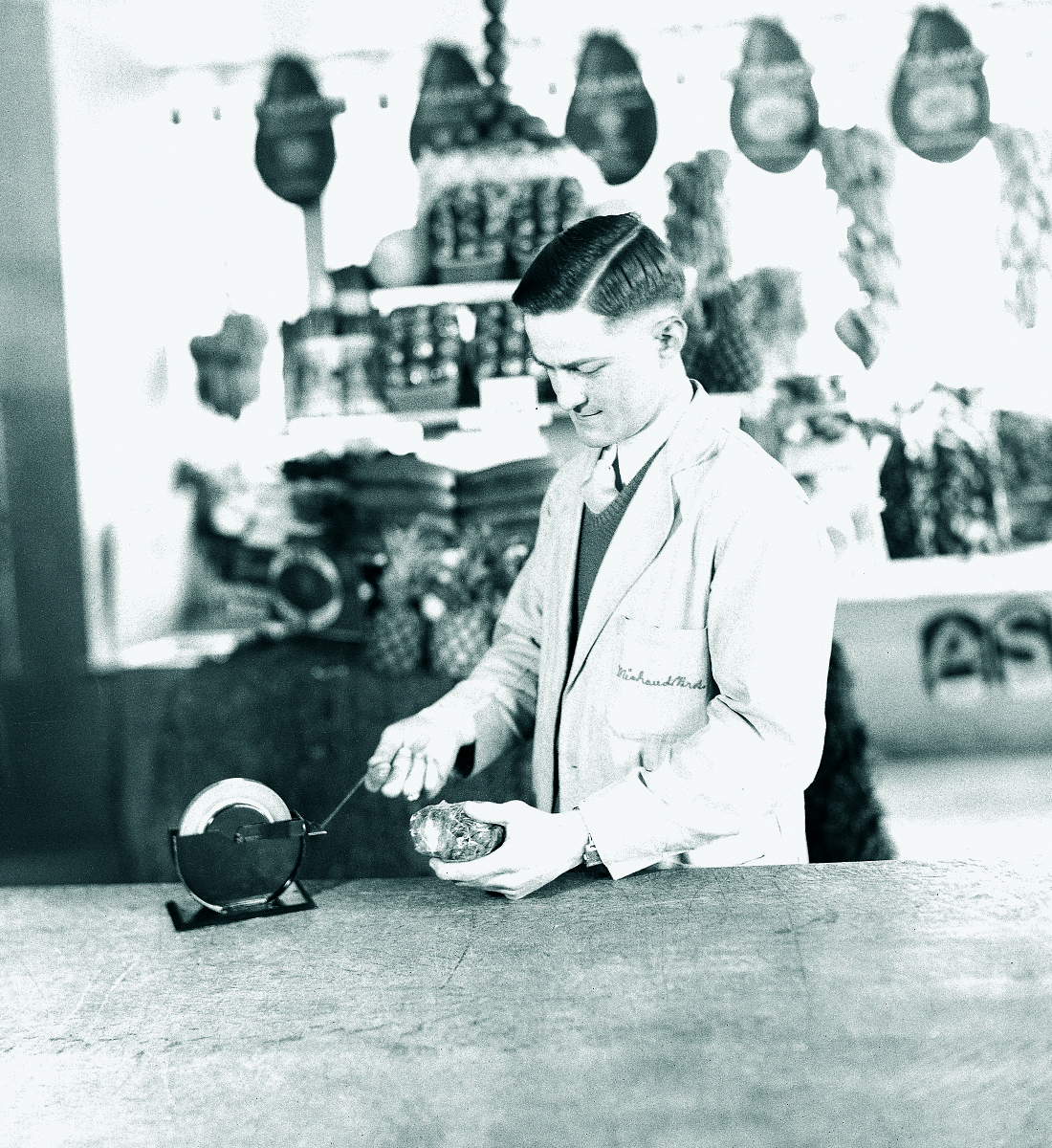
Landmark Designation and Acknowledgments
Landmark Designation
The American Chemical Society designated Scotch® Transparent Tape as a National Historic Chemical Landmark in a ceremony on September 19, 2007, at the 3M Company in St. Paul, Minnesota. The text of the plaque commemorating the landmark reads:
In 1925 Richard Drew invented Scotch® Masking Tape, which marked 3M’s entry into tape manufacturing. Five years later Drew invented Scotch® Transparent Tape, the first waterproof, clear adhesive tape. Introduced during the Great Depression, Scotch Transparent Tape quickly filled the need of Americans to prolong the life of items they could not afford to replace. These inventions have grown to a family of more than 900 pressure-sensitive tapes used by professionals and consumers in office, medical, electrical, construction, and many other applications.
Acknowledgments
Adapted for the internet from “Scotch® Transparent Tape,” produced by the National Historic Chemical Landmarks program of the American Chemical Society in 2007.
3M, Scotch®, and Post-it® are trademarks of 3M Company.
Back to National Historic Chemical Landmarks Main Page.
Learn more: About the Landmarks Program.
Take action: Nominate a Landmark and Contact the NHCL Coordinator.
